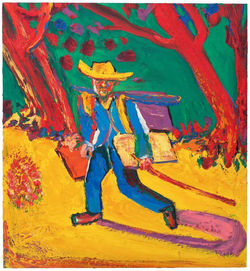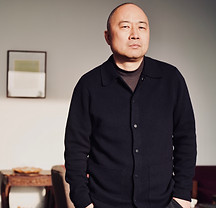This retrospective is a bit different from those Yin Zhaoyang has held in the past. The exhibition stresses neither his reactions to society in painting nor the depiction of the labor inherent in the medium. Instead, based on this painter’s explorations of artistic themes over 20 years, the show aims to interrogate an even older subject: a painter’s ideals.
The exhibition is divided into seven sections. Beginning with his early work from the 1990s, the show describes Yin Zhaoyang’s art historical influences. His painting Flowers, in the style of Munch or van Gogh, represents the embryonic form of his spirit as a painter. In the late 1990s, straitened circumstances, as well as the application of photography, video, and computer technologies, shifted Yin’s attention from art history to personal experience. This painter became a real worker, and Yin became one of the key artists in the Cruelty of Youth movement. After 2000, with his Myth series, he shifted from depicting reality to visions of the past and present, and his identity as a painter became linked to considerations of politics, philosophy, and literature.
With Landscape series, his identity as a painter was reawakened. Following Paul Cézanne in his path to Mont Sainte-Victoire, the 40-year-old Yin Zhaoyang returned to his home near Mount Song (Songshan) and his painterly style. He blended Eastern and Western characteristics into all-new “contemporary landscapes.” Next, focusing on the lightness and heaviness in painting, we chose drawings that Yin made over the course of two decades. Behind legendary, heroic stories of artistic talent, these drawings offer a subtler kind of observation. “The Production of a Landscape Painting” offers a brief history of landscape painting and compares it to Yin’s own path. To end the show, “Vincent van Gogh and the Square” revisits the symbol of the painter and returns to motifs that have appeared in Yin Zhaoyang’s work over a 20-year period: the personal ideals represented by self-portraits and the collective ideals represented by the public square.
In the course of this exhibition, the viewer sees societal changes and an awareness of painting, as well as shifts in the identity of the painter in different circumstances. In the end “Rebuilding Ideals” does not present painting; it discusses a subject, a painter’s soul and character. In a time of stereotypes, how can a painter find a distinctive mode of existence and state of mind, akin to Bada Shanren’s eccentricity, van Gogh’s madness, Bacon’s violence, Rothko’s sorrow, or Freud’s gravity? They may not have certain beliefs about society or be perfect symbols, but they can never lose their ideals as painters. They live based on stubbornness and freedom. In their radicalism, intractability, and arrogance, they found the weight that allowed them to settle into their lives as painters.
Particularly right now, Vincent van Gogh and Mark Rothko have universal meaning as ideals or spiritual guides. This could lead to fabrications, but fabrications and arrogance are much more powerful today than change and mediocrity. In other words, “Rebuilding Ideals” reaffirms the individual, rather than the collective; it casts off the influence that our times have on us in favor of reshaping the individual and rebuilding ideals. Because of the classicism and modernity that these ideals declare, the sublime and the desire to build mark a return to an old tradition that has remained uninterrupted since the rise of classicism and modernism.
 Bloody DuskWatercolor on paper 47 x 54 cm 2021 |  Cold ForestSketch on paper 54.8 × 78.5 cm 2014 |  Cold ForestSketch on paper 21.5 × 30.5 cm 2014 |
|---|---|---|
 Cold ForestSketch on paper 30.3 × 20 cm 2014 |  WarOil on canvas 150 × 130 cm 1999 |  Outside the WindowOil on canvas 100 × 80 cm 1995 |
 Bound GiantOil on canvas 220 × 180 cm 2010 |  MiddayOil on canvas 150 × 75 cm 1999 |  Mount Song 005Wet-plate photograph 30 x 40 cm 2015 |
 Copy of Mont Sainte-VictoireOil on canvas 65 × 85 cm 2017 |  Taishi MountainOil on canvas 131 × 180 cm 2019 |  Snow ValleyOil on canvas 180 × 200 cm 2019 |
 Hero Disappeard No.3Oil on canvas 95 × 112 cm 2000 |  A Young ManOil on canvas 100 × 80 cm 2005 |  SketchWatercolor on paper 25.3 x 25.5 cm 1993 |
 ExercisePastel on paper 68 x 52 cm 2021 |  Blood and SoulOil on canvas 100 x 80 cm 2009 |  FlowersOil on canvas 80 x 65 cm 1997 |
 ChaosOil on canvas 200 × 200 cm 2009 |  SunriseWatercolor on paper 50 x 71 cm 2022 |  Exercise in the SunWatercolor on paper 26 x 19 cm 2021 |
 Blue ExerciseWatercolor on paper 26 x 19 cm 2021 |  Van Gogh in the Sun No.3Oil on canvas 130 x 120 cm 2021 |  Ferocious AnimalsOil on canvas 130 x 180 cm 2009 |
Artist

Yin Zhaoyang
Yin Zhaoyang was born in 1970, Nanyang, Henan Province, China. He graduated from Central Academy of Fine Arts in 1996. He currently lives and works in Beijing.
Represented by Yin Zhaoyang and other artists, “Cruelty of Youth Paintings” in the late 1990s have added to this category an experimental dimension and enhanced its depth of thinking in terms of narrativity, pictorial concept and aesthetic taste, constituting a major tendency in avant-garde painting of a decade.
In his later series of works such as “Myth”, “Utopia”, “Façade”, through in-depth internal inquiry and complex yet profound language exploration, he completed the transformation from experiencing the sensitive youth to a deeper spiritual world, and became an important representative of China's "new painting".
Since 2011, Yin Zhaoyang has turned to a "spiritual landscape" with a strong personal temperament, a keen contemporary perspective, and a profound tradition. With a magnificent and pure painting language, he has developed a new scope of painting that includes both personal and social, historical and present landscape.
Curator

Cui Cancan
Cui Cancan is an active Chinese independent curator and critic.
He has won CCAA (Chinese Contemporary Art Award) Art Review Award for Youth, Critics’ Award in Chinese contemporary art by YISHU, Annual Exhibition Award by Art Power 100, Nominee for Lincoln Curator Prize by TANC Asia Prize, The Best Artist Solo Exhibition of the Year Award by Chinese Contemporary Art News, Best Exhibition Award by Gallery Week Beijing, Annual Curator Award by Art Bank, et cetera.
Since 2012, he has curated almost 100 major exhibitions, including group exhibitions like Hei Qiao Night Way (2013), Rural Wash, Cut and Blow-dry(2013), FUCKOFF II (2013), Unlived by What is Seen (2014), Between the 5th and 6th Ring Road in Beijing (2015), The Decameron (2016), Rip it Up (2017), Spring Festival Projects (2018) , The Curation Workshop (2019) and Nine-Tiered(2020). He has curated artists’ solo exhibitions such as Ai Weiwei, Bao Xiaowei, Chen Danqing, Chen Yufan, Chen Yujun, Feng Lin, Han Dong, He Yunchang, Huang Yishan, Jiang Bo, Li Binyuan, Liu Gangshun, Liu Jianhua, Li Qing, Li Zhanyang, Ding Muer, Ma Ke, Mao Yan, Qin Qi, Sui Jianguo, Shijiezi Art Museum, Shi Jinsong, Shen Shaomin, Tan Ping, Wang Qingsong, Xie Nanxing, Xia Xiaowan, Xia Xing, Xiao Yu, Xu Zhongmin, Xu Xiaoguo, Zong Ning, Polit-Sheer-Form, Zhang Yue and Zhao Zhao et cetera.



